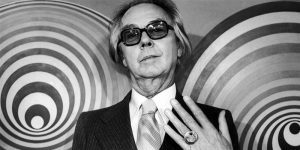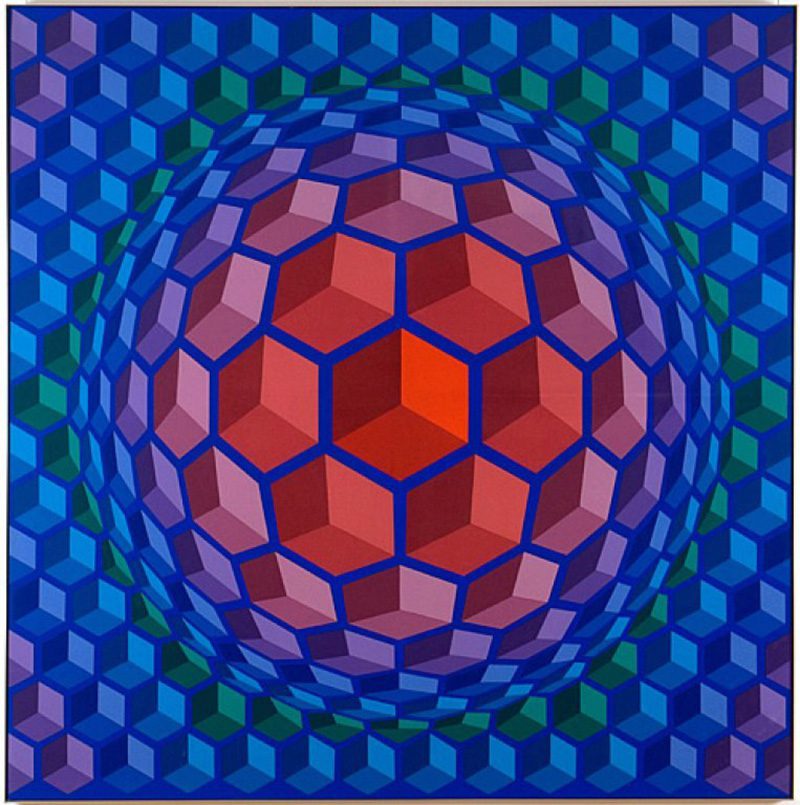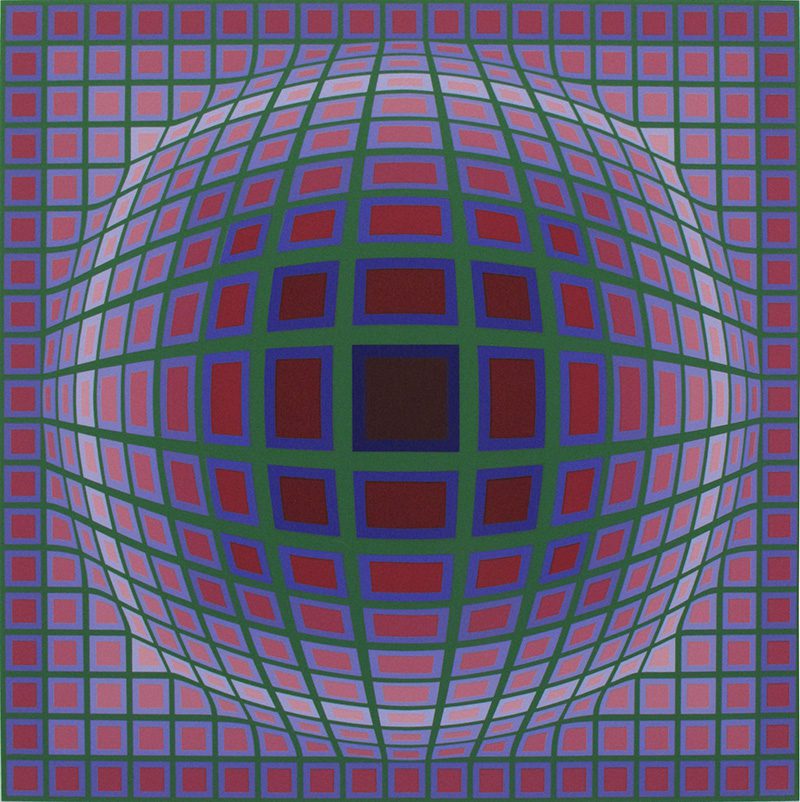TRACES: Victor Vasarely
 The seeds of an Art Movement are often planted decades before they sprout and bloom. Today is the occasion to bear in mind Victor Vasarely (9/4/1906-15/3/1997), who widely regarded as the father of Op-Art. His works entitled “Zebra”, created in the late ‘30s, are considered to be the earliest examples of Op Art. Vasarely eventually went on to produce paintings and sculptures mainly focused around the area of optical illusion. Through documents or interviews, starting with: moments and memories, we reveal out from the past-unknown sides of big personalities, who left their indelible traces in time and history…
The seeds of an Art Movement are often planted decades before they sprout and bloom. Today is the occasion to bear in mind Victor Vasarely (9/4/1906-15/3/1997), who widely regarded as the father of Op-Art. His works entitled “Zebra”, created in the late ‘30s, are considered to be the earliest examples of Op Art. Vasarely eventually went on to produce paintings and sculptures mainly focused around the area of optical illusion. Through documents or interviews, starting with: moments and memories, we reveal out from the past-unknown sides of big personalities, who left their indelible traces in time and history…
By Dimitris Lempesis
 Victor Vasarely in 1925 was accepted at the University of Budapest’s School of Medicine where he spent two years studying. In 1927 Vasarely made a radical and life changing decision, he decided to suspend his studies in medicine and change direction completely, the following two years Vasarely studied traditional painting. Vasarely began to develop an idea that the sciences had reached the limits of what could be explained and that it was through art that these scientific models could be made visually comprehensible. He enrolled in the Muhely in 1929. The school worked very much to the goals of the original Bauhaus. The basic concepts of the teaching were that all the arts and crafts and architecture should achieve a unity of purpose based on the cube, the rectangle and the circle. In 1930, looking for something more, Vasarely moved to Paris. Vasarely’s work the period 1930-44 was largely figurative and concerned with the graphic image, but within it lay the kinetic and optical seeds of his later mature work. A major change in Vasarely’s style came about after his first important exhibition at the Denise Rene Gallery in 1944. In 1947 Vasarely began to move from paintings that were abstract but evolved from representational images, to abstract works composed entirely of geometric shapes. Between 1951 and 1959 ΗΕ continued working with geometric shapes and also began to paint predominantly in black and white. In the works of this period we can see the development of what we have come to know as Op Art. In 1955 he published his “Yellow Manifesto” in which he returned to the teachings of his Bauhaus training to outline his concept of “Plastic kinetics”. For the artist “Painting and sculpture become anachronistic terms: it’s more exact to speak of bi-, tri- and multidimensional plastic art. We no longer have distinct manifestations of a creative sensibility, but the development of a single plastic sensibility in different spaces”. Vasarely received the critics award in Brussels and the Gold Medal at the Milan Triennial as a result of his manifesto. During 1960-65, Vasarely evolved his “Alphabet Plastique”, a grid based system which established modular relationships between forms and colors. This period marked the reintroduction of color to Vasarely’s works in the two major series of this time, “Alphabet Plastique” and “Folklore Planetaire”. In 1965 when Vasarely exhibited at an exhibition called “The Responsive Eye” at MoMA, alongside other important Op Artists like Bridget Riley. Vasarely was immediately dubbed the “Father of Op Art”. The reaction of the public to the exhibition was euphoric and for the next few years Op Art spread to advertising, packaging, fashion and design. In 1968, Victor Vasarely started another series of paintings which became hugely popular and widely known as the “Vega” series. In these series we see some of the most advanced applications of Vasarely’s systematic approach to form and colour. The paintings are based on spherical distortions to a polychromatic grid. The surface appears to have been warped, giving the feeling of something trying either to break out or to recede back into the depths of the surface. Vasarely continued to explore depth and movement in his highly structured paintings well into his seventies. These paintings are as exciting and innovative as the works of his earlier years. In 1970 Vasarely opened his first dedicated museum in Gordes, France (Closed in 1996). The Vasarely Foundation museum opened in 1976 in Aix-en-Provence, France, as did the Vasarely museum in Pecs, Hungary, in 1987 a further Vasarely museum opened in Zichy Palace in Budapest. Victor Vasarely died in Paris.
Victor Vasarely in 1925 was accepted at the University of Budapest’s School of Medicine where he spent two years studying. In 1927 Vasarely made a radical and life changing decision, he decided to suspend his studies in medicine and change direction completely, the following two years Vasarely studied traditional painting. Vasarely began to develop an idea that the sciences had reached the limits of what could be explained and that it was through art that these scientific models could be made visually comprehensible. He enrolled in the Muhely in 1929. The school worked very much to the goals of the original Bauhaus. The basic concepts of the teaching were that all the arts and crafts and architecture should achieve a unity of purpose based on the cube, the rectangle and the circle. In 1930, looking for something more, Vasarely moved to Paris. Vasarely’s work the period 1930-44 was largely figurative and concerned with the graphic image, but within it lay the kinetic and optical seeds of his later mature work. A major change in Vasarely’s style came about after his first important exhibition at the Denise Rene Gallery in 1944. In 1947 Vasarely began to move from paintings that were abstract but evolved from representational images, to abstract works composed entirely of geometric shapes. Between 1951 and 1959 ΗΕ continued working with geometric shapes and also began to paint predominantly in black and white. In the works of this period we can see the development of what we have come to know as Op Art. In 1955 he published his “Yellow Manifesto” in which he returned to the teachings of his Bauhaus training to outline his concept of “Plastic kinetics”. For the artist “Painting and sculpture become anachronistic terms: it’s more exact to speak of bi-, tri- and multidimensional plastic art. We no longer have distinct manifestations of a creative sensibility, but the development of a single plastic sensibility in different spaces”. Vasarely received the critics award in Brussels and the Gold Medal at the Milan Triennial as a result of his manifesto. During 1960-65, Vasarely evolved his “Alphabet Plastique”, a grid based system which established modular relationships between forms and colors. This period marked the reintroduction of color to Vasarely’s works in the two major series of this time, “Alphabet Plastique” and “Folklore Planetaire”. In 1965 when Vasarely exhibited at an exhibition called “The Responsive Eye” at MoMA, alongside other important Op Artists like Bridget Riley. Vasarely was immediately dubbed the “Father of Op Art”. The reaction of the public to the exhibition was euphoric and for the next few years Op Art spread to advertising, packaging, fashion and design. In 1968, Victor Vasarely started another series of paintings which became hugely popular and widely known as the “Vega” series. In these series we see some of the most advanced applications of Vasarely’s systematic approach to form and colour. The paintings are based on spherical distortions to a polychromatic grid. The surface appears to have been warped, giving the feeling of something trying either to break out or to recede back into the depths of the surface. Vasarely continued to explore depth and movement in his highly structured paintings well into his seventies. These paintings are as exciting and innovative as the works of his earlier years. In 1970 Vasarely opened his first dedicated museum in Gordes, France (Closed in 1996). The Vasarely Foundation museum opened in 1976 in Aix-en-Provence, France, as did the Vasarely museum in Pecs, Hungary, in 1987 a further Vasarely museum opened in Zichy Palace in Budapest. Victor Vasarely died in Paris.















